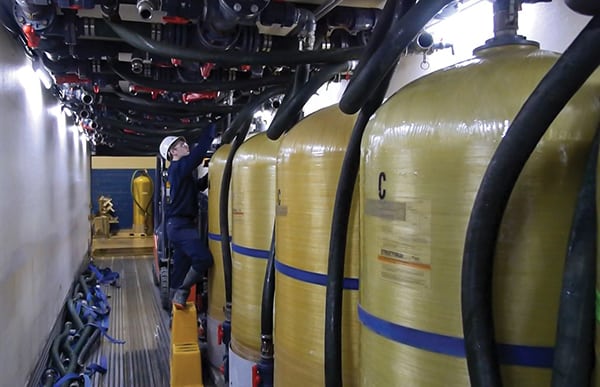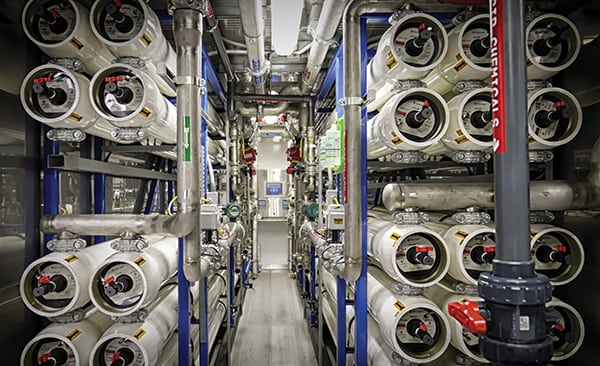When commissioning a new power plant, requirements for purified water can be large—often more than an unfinished plant can supply. When it’s time to bring in outside help, proper planning can help avoid problems and keep budgets under control.
With all the complexity inherent in the commissioning of a power plant, the last thing anyone needs is an interruption in the supply of purified water. A little planning, however, can assure engineers and managers that they will have all the water that meets their quality and quantity requirements, while eliminating inefficiencies and unnecessary costs.
Whether it’s hydrotesting the pipes and tanks or conducting steam blows to clean the new system before its startup, a power plant commissioning requires a lot of demineralized water. Furthermore, the quantity of water required often exceeds the capacity of the onsite water treatment system, which may be either still under construction or still being tested in conjunction with the commissioning. As a result, commissioning managers must often turn to water purification suppliers and their mobile technologies to meet water requirements.
Know Your Feedwater
Knowing what’s in the feedwater is the first step to designing a proper treatment system. That’s why a comprehensive understanding of the water source is critical to developing a purification process that can meet specifications. Water purification firms typically collect a sample of the feedwater during the planning phase and submit it to a laboratory for an analysis, which should include:
■ Turbidity, a measure of the cloudiness or haziness caused by individual particles suspended in the feedwater.
■ The pH, for selecting the chemical pretreatment that will be used in the filtration process.
■ A list of the cations, anions, and their concentration levels.
■ Conductivity, which can serve as a proxy for and be calculated from the previous item.
All of these measures play a role in designing a purification process, and all are important for designing a cost-effective temporary treatment system.
Turbidity is expressed in NTU, or nephelometric turbidity units, using a turbidimeter, which measures the intensity of light scattered at 90 degrees as a beam passes through the water sample.
If the feedwater contains iron, manganese, or especially high levels of organics, then a total suspended solids (TSS) analysis is highly recommended. TSS can provide a more accurate assessment of purity because iron, manganese, and organics can impart color to the feedwater. This can create a false sense of how much material is suspended in the water and cause engineers to use more purification equipment than necessary.
TSS is a measure of the dry weight of the suspended particles. A measured volume of feedwater is poured through a pre-weighed filter, which is dried and re-weighed. TSS is often measured in milligrams per liter from the volume of water filtered. TSS can then be correlated with turbidity, and turbidity can be easily and quickly measured with a handheld device in the field.
Sources of suspended solids, which are common in surface water, include decaying tree branches and leaves; sediments from storm water runoff; storm water pollution from paved surfaces such as roads, bridges, and parking lots; and colloidal rock particles from quarrying, mining, and coal recovery. If not reduced to required levels, this organic matter can form acids when heated in power plant boilers, causing corrosion.
The pH and alkalinity are critical to the effective selection of proper coagulation chemistry. Inorganic coagulants are typically selected for short-term projects due to the ease of deployment and lower cost. These chemicals are more sensitive to pH ranges and the amount of alkalinity than organic chemistries. A representative sample of feedwater can be tested against a batch of different chemicals to achieve a proper floc formation for the filtration process.
Total dissolved solids (TDS) is primarily a measure of the inorganic cations and anions dissolved in the water. Gravimetric methods are the most accurate measure of TDS. This involves evaporating the liquid solvent and measuring the mass of residues left. These methods, however, are time-consuming and must be performed in a laboratory. Conductivity, meanwhile, is another measure of TDS, which quantifies the electric current from the cations and anions. Conductivity can be measured in the field with a handheld device and generates results that are within approximately 10% of the accuracy of gravimetric methods. As a result, many water purification professionals correlate conductivity with gravimetric methods to ensure that purification processes in the field are meeting requirements.
Primary sources of dissolved solids include agricultural and residential runoff, leaching of soil contamination, and point-source water pollution discharge from industrial or sewage treatment plants. The most common inorganic constituents are calcium, magnesium, sodium, potassium, iron, alkalinity, chloride, sulfate, nitrate, and silica.
Look Beyond the Lab
Laboratory data collected from feedwater samples is important, but it is by no means the only source of information that can assist with developing a purification process. For example, does the plant have any analytics on the feedwater based on the operations of its permanent system on site? These can shed light on seasonal variations, which can be helpful if the commissioning takes longer than expected, which is not uncommon.
Gathering historical data for the supply water reveals trends in the amount of deviation from normal and the length of time before it reverts to the norm. Rainfall, seasons, and other weather conditions all influence turbidity.
Engineers can also check with the local municipal water authority for analytics if the agency uses the same feedwater.
Finally, it’s a good idea to check with neighboring industrial facilities that use the same feedwater in their processes. Assuming they’re not competitors, they might be willing to share their data.
In the end, the better the quantity and quality of data, the more effectively the water purifier can minimize costs and meet requirements during commissioning. Any misstep in the chemical evaluation of the feedwater, however, can have dramatic impacts on the purification process. If, for example, the purified water doesn’t meet requirements, then the water firm might need to bring additional resources on site, which could consume valuable time and delay the commissioning.
Consider All Your Options
In virtually every feedwater scenario, there is more than one way to generate the required quality and quantity of purified water. Nonetheless, most approaches comprise a two-step process: coagulant filtration followed by demineralization.
To more effectively filter out suspended solids, coagulants/flocculants are added to the feedwater. Relatively inexpensive inorganic coagulants have a positive electrical charge when dissolved in water, opposite of the negative electrical surface charge of some suspended solids. As a result, this neutralizes the colloidal solids, allowing them to fall out of suspension. However, smaller particles often need to be gathered together to have enough size to be effectively filtered. Flocculants are used to do just that, providing a larger precipitant that attracts the smaller particles. Alum is typically the most cost-effective inorganic coagulant when there is an adequate amount of alkalinity of the feedwater.
Removing dissolved inorganics, or demineralization, is often conducted through the use of an ion-exchange process (Figure 1). Demineralization removes minerals through a chemical process of exchanging one ion for another using ion-exchange resins. These resins are small, specially manufactured plastic beads that contain electrically charged exchange sites. They selectively attract ions and replace them with hydrogen or hydroxide ions.
Reverse Osmosis Can Help Reduce Total Costs
If the feedwater contains high levels of TDS, and if large volumes of purified water are required, water purification firms will sometimes employ reverse osmosis (RO) technology before the water is treated with demineralization.
Osmosis is the natural movement of water molecules from a low-ion concentration to a higher-ion concentration across a semipermeable membrane. RO reverses that process by applying pressure to the feed side of the membrane, pushing water back across the divide to the less-concentrated permeate side, reducing TDS by 98% or more (Figure 2). The remaining dissolved solids can then be easily addressed with demineralization.
As a result, this minimizes the number of demineralization trailers needed for a commissioning, significantly reducing costs. The job duration and TDS play a role in the cost-benefit analysis.
Another way to save money is to locate the mobile water purification systems as close to existing water treatment facilities as possible. This reduces the cost of moving the feedwater to the temporary water purification process and back. Additional hoses and pumps can add to the costs and the complexity of installing the mobile purification system.
It’s also a good idea to locate the purification technology near existing electrical service. Depending on the duration of the assignment, the use of generators to power the purification technology can add significant cost and environmental issues related to the use of diesel fuel.
Don’t Forget the Waste Stream
One of the least-appreciated aspects of supplying water for hydrotesting and steam blows is addressing the wastewater generated from the purification process. Regardless of the purification method, the material removed from the feedwater must be removed from the power plant site.
Materials captured by the filters in the coagulation-filtration process are removed via a backwashing step. This wastewater is collected, and in some cases it can be processed at the power plant’s existing wastewater treatment system, such as a settling pond, which can save money. If the plant’s wastewater system isn’t available, then the backwash is often placed in a settling tank brought on site, allowing the particles to accumulate on the bottom. When settled, the water can be discharged and the solids removed and hauled away for disposal.
The concentrated waste stream from the RO technology can be handled in a similar manner. RO systems recover approximately 75% of the feedwater. Put another way, 25% of the water treated through RO becomes wastewater, and if the power plant doesn’t have a discharge permit, then the wastewater will have to be collected and transported offsite, which in many cases makes RO infeasible.
The good news with demineralization trailers is that the resin beds that collect the unwanted ions are taken offsite for regeneration, meaning there are no regeneration waste streams to consider and no regenerate chemicals needed on site. With the use of a pretreated feedwater supply, such as a drinking water supply, a demineralization trailer can be deployed as a zero liquid discharge system.
Making It All Work
Purified water is critical to a successful commissioning. Any interruption in the quantity or quality of water can generate additional costs and cause significant delays in a complex and highly interrelated process.
As a result, water purification personnel and commissioning professionals need to possess a comprehensive understanding of a power plant’s feedwater and thoroughly review the multiple methods for meeting purity requirements. In addition, they need to develop an approach for disposing the wastewater generated from the purification process that is compatible with the power plant’s regulatory requirements and yet minimizes costs. The energy and time devoted on these and related topics during the planning stage can prevent water from putting a damper on the commissioning of any power plant. ■
—Max Swoboda (mswoboda@mpwservices.com) is technical services manager for MPW Industrial Services.
https://www.powermag.com/prevent-purified-water-putting-damper-next-commissioning/

